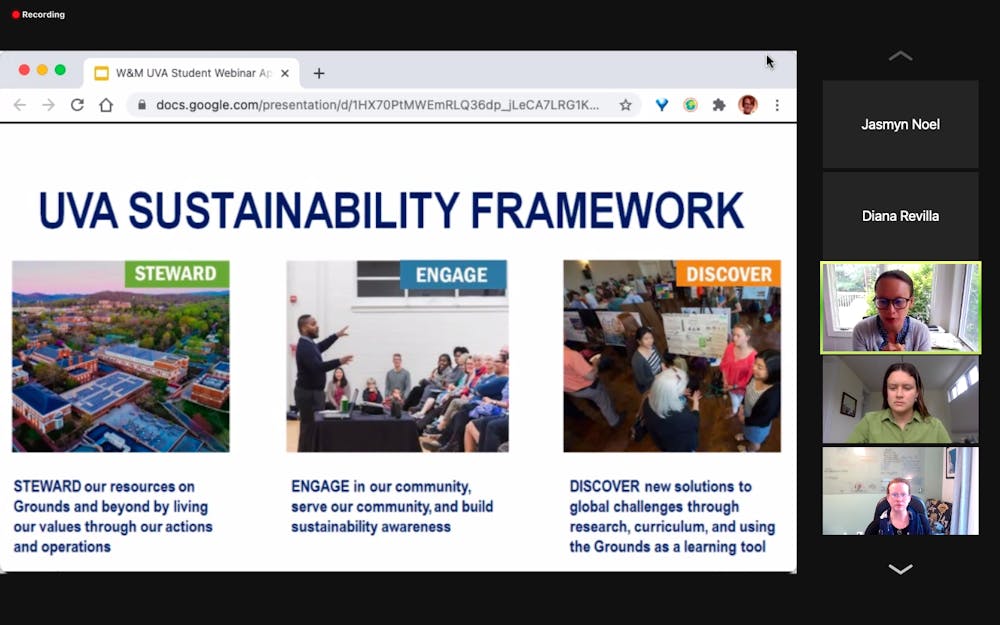The University and the College of William & Mary shared progress, challenges and new initiatives for their joint 2030 Sustainability Plan in a webinar Wednesday afternoon. Sustainability Directors Andrea Trimble and Calandra Waters Lake — representing the University and William & Mary, respectively — explained the action plans they created and provided updates about the initiative’s progress so far.
Before winter 2019, the universities were separately working on climate action plans focused on achieving carbon neutrality by 2030. Carbon neutrality — or net zero carbon emissions achieved by stopping emissions and removing carbon dioxide from the environment — became a popular goal in recent decades as environmental scientists have made renewable energy more efficient and thus more realistic as a primary source of energy.
These plans came about following an executive order from Governor Ralph Northam that set a goal for Virginia to achieve 100 percent carbon-free energy production by 2050. In the order, Northam urged Virginia’s higher education institutions to create plans that aligned with the 2050 carbon-free goal, prompting the creation of the climate action plans in the sustainability offices of both universities.
When the two universities realized the parallels between their work, including independently choosing 2030 as their target dates for becoming carbon-neutral, they decided to pool research and tools to help each other advance their sustainability efforts.
“With similar goals, challenges, research interests, and both being public institutions, U.Va. and William & Mary’s partnership makes a lot of sense,” Lake said.
Currently, the main partnership goal involves “operational aspects” of the 2030 carbon-neutrality goal, according to Trimble. This means working through plans to adjust campus operations like construction, heating and cooling, food and campus vehicles to be more sustainable.
For example, William & Mary recently completed a large-scale solar power project with Dominion Energy. Both sustainability directors expressed interest in expanding solar plants as carbon-free energy sources in the coming years.
“We signed a power purchase agreement and there is now a solar farm being built by William Mary,” Lake said. “This will take up about 50 percent of the energy William & Mary uses.”
The University’s 2030 Sustainability Plan is referred to as “30 by 30,” as the University aims to reduce water use and reactive nitrogen emissions by 30 percent, reduce the University’s waste footprint to 30 percent and increase food sustainability by 30 percent — all relative to 2010 consumption levels — by 2030.
The Climate Action Plan is still a work in progress and completing a draft of the plan to share with the University Committee on Sustainability is a major goal for Director Trimble’s office.
Over the last two years, both sustainability offices have worked towards these goals through a three-factor climate action plan — engage, which centers around civic engagement; discover, which focuses on discovering new solutions to global challenges through teaching and research; and steward, which involves actually living these sustainability values through actions and operations on Grounds and beyond.
Most recently, the University has unveiled two websites tracking progress on the 2030 sustainability plan. The first, the renewable energy tracker, includes information on the five buildings on Grounds with solar panels — Alderman Library, Clemons Library, Ridley Hall, Skipwith Hall and the University bookstore — and the three University solar facilities as well as real-time updates on solar power production on Grounds. Similarly, the University building performance and energy tracker allows users to see the progress in construction energy efficiency and the general energy usage of the buildings on Grounds.
A major goal of both the University and William & Mary’s sustainability offices is increasing student involvement in their efforts.
“People don't have to be all about sustainability to help with this plan,” Lake said. “We want to meet people where they’re at.”
In Trimble’s presentation, she added that the University aims to incorporate more students into the next steps of the climate action plan through creating student groups that investigate and provide feedback on areas such as thermal energy and university vehicle management, educational and internship opportunities, the Energy Working Group and ideas sessions.
While these initiatives to get students more involved are still works in progress, some projects have already successfully incorporated students into sustainability projects. For example, the University and William & Mary recently established a joint study abroad program called Sustainability Abroad focused on environmental norms and sustainability efforts internationally.
Through several University study abroad programs focusing on sustainability, students can visit a variety of countries including Denmark, Guatemala, Lithuania and Sweden to learn about sustainability internationally.







